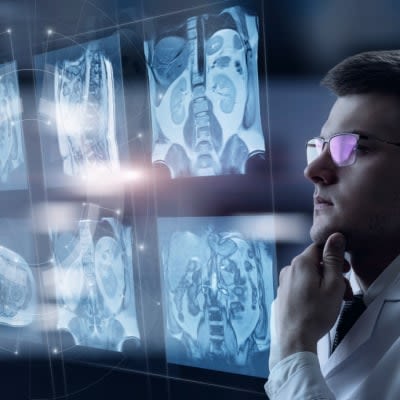The National Health Service (NHS) was created to provide medical care for all, free at the point of use. Now 70 years old, it is a national treasure under intense strain, battling to provide the best modern medicine to an ever-growing, ageing UK population.
Both radiology and clinical oncology are vital to the health service. Most patient diagnoses and pathways are directly influenced by the image interpretation of a radiologist, and with one in two people predicted to be affected by cancer, it is likely a clinical oncologist will be involved in the care of UK citizens or their families at some point.
For both disciplines to survive and support the NHS over the next decade, let alone another 70 years, health officials need to invest in training and properly resourcing these doctors.
Without investment, data from The Royal College of Radiologists’ censuses show that by 2022 the UK’s diagnostic radiologists will be understaffed by 30 per cent, compared with 23 per cent today. That does not cover our increasing need for life saving interventional expertise – which is also stretched dangerously thinly, with only one-in-seven UK hospital trusts and health boards currently able to provide round-the-clock interventional radiology services.
Without investment, by 2022 the UK’s clinical oncologists will be understaffed by more than 20 per cent. These doctors will have growing numbers of cancer cases to manage, but with an exciting and increasingly complex range of treatment options they will be tailoring radiotherapy, chemotherapy and immunotherapy to each patient. In order to ensure this state-of-the-art care for all patients, we must close the staffing gap.
Along with more medics, the NHS needs a well-maintained equipment base, requiring millions more in capital investment. This means a rolling replacement programme for all scanners, as well as radiologist PACS workstations and the IT infrastructure desperately needed to connect clinicians across hospital sites. In terms of clinical oncology equipment, it means funding rolling replacement of the modern linear accelerators, CT scanners and software required to deliver the most effective radiotherapy treatments available.
Artificial intelligence programmes will no doubt be an integral part of the future health service of 2088 and will be helping radiologists and clinical oncologists to spot and treat cancer and other conditions. However, in the short-to-medium term, the NHS desperately needs properly equipped imaging and cancer departments, and enough doctors to give patients the care they deserve.
Both radiology and clinical oncology are vital to the health service. Most patient diagnoses and pathways are directly influenced by the image interpretation of a radiologist, and with one in two people predicted to be affected by cancer, it is likely a clinical oncologist will be involved in the care of UK citizens or their families at some point.
For both disciplines to survive and support the NHS over the next decade, let alone another 70 years, health officials need to invest in training and properly resourcing these doctors.
Without investment, data from The Royal College of Radiologists’ censuses show that by 2022 the UK’s diagnostic radiologists will be understaffed by 30 per cent, compared with 23 per cent today. That does not cover our increasing need for life saving interventional expertise – which is also stretched dangerously thinly, with only one-in-seven UK hospital trusts and health boards currently able to provide round-the-clock interventional radiology services.
Without investment, by 2022 the UK’s clinical oncologists will be understaffed by more than 20 per cent. These doctors will have growing numbers of cancer cases to manage, but with an exciting and increasingly complex range of treatment options they will be tailoring radiotherapy, chemotherapy and immunotherapy to each patient. In order to ensure this state-of-the-art care for all patients, we must close the staffing gap.
Along with more medics, the NHS needs a well-maintained equipment base, requiring millions more in capital investment. This means a rolling replacement programme for all scanners, as well as radiologist PACS workstations and the IT infrastructure desperately needed to connect clinicians across hospital sites. In terms of clinical oncology equipment, it means funding rolling replacement of the modern linear accelerators, CT scanners and software required to deliver the most effective radiotherapy treatments available.
Artificial intelligence programmes will no doubt be an integral part of the future health service of 2088 and will be helping radiologists and clinical oncologists to spot and treat cancer and other conditions. However, in the short-to-medium term, the NHS desperately needs properly equipped imaging and cancer departments, and enough doctors to give patients the care they deserve.
Latest Articles
UK, Radiology, NHS, Royal College of Radiologists, Clinical Oncology
Dr. Nicola Strickland, President of The Royal College of Radiologists (2016-2019) outlines what is needed to ensure radiology and clinical oncology can support the UK's National Health Service (NHS) for another 70 years























